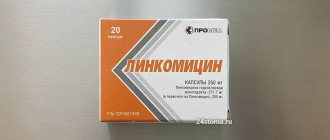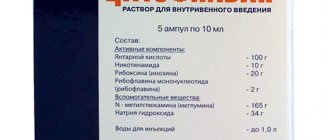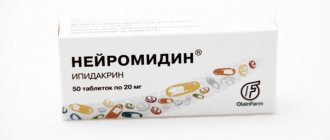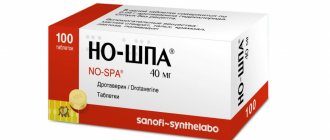Adrenaline hydrotartrate solution 1%
Dosage forms:
0.1% solution of adrenaline hydrochloride for injection in ampoules of 1 ml and in bottles of 30 ml; adrenaline hydrotartrate injection solution 0.18% in ampoules of 1 ml.
Pharmacological group:
drugs acting primarily on peripheral adrenergic processes.
Pharmacological properties
The effect of adrenaline is associated with the influence on a and b adrenergic receptors and largely coincides with the effects of excitation of the sympathetic nerves: it constricts the vessels of the abdominal organs, skin, mucous membrane and, to a lesser extent, the vessels of skeletal muscles; adrenaline increases blood pressure, increases and increases heart rate; in connection with the increase in pressure, a reflex excitation of the center of the vagus nerves occurs, which has an inhibitory effect on the heart, as a result of which the heart rate can slow down. Adrenaline can cause heart rhythm disturbances (tachycardia, extrasystole), especially with coronary heart disease, as well as during anesthesia during operations.
Adrenaline relaxes the muscles of the bronchi and intestines, dilates the pupils, improves the functional activity of skeletal muscles, increases blood sugar, enhances tissue metabolism, and increases the myocardium's need for oxygen.
In terms of the action of adrenaline, hydrotartrate does not differ from adrenaline hydrochloride, but due to the difference in relative molecular weight, hydrotartrate is used in a higher concentration to obtain the same effect.
INDICATIONS FOR USE
Adrenaline hydrochloride and adrenaline hydrotartrate are used for anaphylactic shock, allergic laryngeal edema, and to relieve acute attacks of bronchial asthma; allergic reactions that develop when using drugs or other allergens, in patients with acute myocardial infarction with ventricular fibrillation, refractory to electrical defibrillation, and sudden cardiac arrest (asystole); with acute left ventricular failure; as a local vasoconstrictor.
CONTRAINDICATIONS
Adrenaline is contraindicated in hypertension, aneurysms, severe atherosclerosis, bleeding, and pregnancy. Adrenaline should not be used during anesthesia with fluorotane, cyclopropane, or chloroform (risk of developing arrhythmia).
SPECIAL INSTRUCTIONS
Use with caution in diabetes mellitus and hyperthyroidism.
METHOD OF APPLICATION AND DOSES
Adrenaline is administered subcutaneously, intramuscularly, intravenously (drip slowly) 0.2 - 0.3 - 0.5 - 1 ml of 0.1% hydrochloride solution or 0.18% hydrogen tartrate solution, intracardially in case of acute cardiac arrest - 1 ml and for ventricular fibrillation - 0.5 - 1 ml, and also applied to the mucous membranes as a local vasoconstrictor.
During an attack of bronchial asthma, solutions of adrenaline are administered 0.3 - 0.5 - 0.7 ml subcutaneously.
Therapeutic doses of solutions of adrenaline hydrochloride 0.1% and hydrogen tartrate 0.18% for parenteral administration are usually 0.3 - 0.5 - 0.75 ml for adults; Children, depending on age, are administered 0.1 - 0.5 ml. Higher doses for adults under the skin: single - 1 ml, daily - 5 ml.
SIDE EFFECT
Administration of adrenaline hydrochloride and hydrogen tartrate can cause increased blood pressure, tachycardia, arrhythmia, and pain in the heart area. For rhythm disturbances caused by adrenaline, beta-blockers (anaprilin, obzidan, etc.) are prescribed.
RELEASE FORM
Adrenaline hydrochloride is produced in the form of a 0.1% solution, adrenaline hydrotartrate - in the form of a 0.18% solution in ampoules, 1 ml of neutral glass and in hermetically sealed orange glass bottles (for topical use) of 30 ml.
STORAGE CONDITIONS
List B. In a cool (12-15°C), protected from light place. Keep out of the reach of children.
BEST BEFORE DATE
3 years. Do not use after the expiration date indicated on the package. Solutions that have turned brown or contain sediment are not suitable for use.
CONDITIONS OF VACATION FROM PHARMACIES
The drug is used in a hospital.
Buy Adrenaline hydrochloride injection solution 0.1% 1ml No. 5 in pharmacies
Buy Adrenaline hydrochloride in pharmacies Adrenaline hydrochloride in the drug directory DOSAGE FORMS solution 0.1%
MANUFACTURERS Moscow endocrine plant (Russia) Ferein (Russia)
GROUP Drugs that stimulate alpha and beta adrenergic receptors
COMPOSITION Active substance: Epinephrine.
INTERNATIONAL NON-PROPENTED NAME Epinephrine
SYNONYMS Adrenaline, Synthetic adrenaline, Adrenaline hydrochloride-Vial
PHARMACOLOGICAL EFFECT Cardiostimulating, vasoconstrictor, hyperglycemic, hypertensive. Stimulates alpha and beta adrenergic receptors. When administered parenterally, it is very quickly destroyed by monoamine oxidase and catechol-O-methyltransferase in liver cells, kidneys, intestinal mucosa, and axons. The half-life is 1-2 minutes. Excretion of metabolites is carried out by the kidneys. It has a pronounced effect on the smooth muscles of internal organs, the cardiovascular and respiratory systems, and activates fat and carbohydrate metabolism. The first phase of action is primarily due to stimulation of beta-adrenergic receptors of various organs and is manifested by tachycardia, increased cardiac output, increased excitability and conductivity of the myocardium, arteriolo- and bronchodilation, as well as decreased uterine tone, inhibition of allergic reactions and mobilization of glycogen from the liver and fatty acids from fatty acids. depot Then alpha-adrenergic receptors are excited and the vessels of the abdominal organs, skin, mucous membranes, and, to a lesser extent, skeletal muscles narrow, blood pressure (mainly systolic), and general peripheral vascular resistance increase; the pressor effect can cause a short-term reflex slowing of the heart rate.
INDICATIONS FOR USE Anaphylactic shock, bronchospastic syndrome, hypoglycemia due to insulin overdose, open-angle glaucoma.
CONTRAINDICATIONS Arterial hypertension, widespread atherosclerosis, thyrotoxicosis, diabetes mellitus, angle-closure glaucoma, pregnancy. Adrenaline should not be used during anesthesia with fluorotane or cyclopropane (due to the development of arrhythmias).
SIDE EFFECTS Increased blood pressure, cardiac arrhythmias, ventricular fibrillation, anxiety, tremor of skeletal muscles, angina pectoris, tachycardia, headache, nausea.
INTERACTION Enhances the effect of aminophylline and drugs that increase thyroid function.
METHOD OF APPLICATION AND DOSAGE Therapeutic doses of adrenaline hydrochloride for parenteral administration are usually 0.3-0.5-0.75 ml of a 0.1% solution for adults. Depending on age, children are administered 0.1-0.5 ml of solution. Higher single doses: 0.1% solution of adrenaline hydrochloride and 0.18% solution of adrenaline hydrotartrate for adults under the skin: single 1 ml, daily 5 ml.
OVERDOSE No information available.
SPECIAL INSTRUCTIONS For the prevention of arrhythmias against the background of epinephrine, beta-blockers are indicated
STORAGE CONDITIONS List B. Store in a cool, dry place.
Adrenalin
During infusion, a device with a measuring device should be used to regulate the rate of infusion.
Infusions should be carried out into a large (preferably central) vein.
Intracardiac administration during asystole, if other methods are not available, because there is a risk of cardiac tamponade and pneumothorax.
During the treatment period, it is recommended to determine the concentration of K+ in the blood serum, measure blood pressure, diuresis, IOC, ECG, central venous pressure, pressure in the pulmonary artery and wedge pressure in the pulmonary capillaries.
Excessive doses during myocardial infarction may increase ischemia by increasing myocardial oxygen demand.
Increases glycemia, and therefore diabetes mellitus requires higher doses of insulin and sulfonylurea derivatives.
When administered endotracheally, absorption and final plasma concentrations of the drug may be unpredictable.
The administration of epinephrine during shock does not replace transfusions of blood, plasma, blood substitute fluids and/or saline solutions.
Epinephrine is not advisable for long-term use (constriction of peripheral blood vessels, leading to the possible development of necrosis or gangrene).
There are no strictly controlled studies of the use of epinephrine in pregnant women. A statistically consistent relationship has been established between the appearance of deformities and inguinal hernia in children whose mothers used epinephrine during the first trimester or throughout pregnancy; it was also reported in one case that anoxia occurred in the fetus after intravenous administration of epinephrine to the mother. Epinephrine should not be used in pregnant women with blood pressure above 130/80 mmHg. Experiments on animals have shown that when administered in doses 25 times higher than the recommended dose for humans, it causes a teratogenic effect.
When used during breastfeeding, the risks and benefits should be assessed due to the high likelihood of side effects in the child.
Use to correct hypotension during labor is not recommended as it may delay the second stage of labor; when administered in large doses to weaken uterine contractions, it can cause prolonged uterine atony with bleeding.
Can be used in children with cardiac arrest, but caution should be exercised as the dosing regimen requires 2 different concentrations of epinephrine.
When stopping treatment, the dose should be reduced gradually, because Abrupt discontinuation of therapy may result in severe hypotension.
Easily destroyed by alkalis and oxidizing agents.
If the solution has turned pinkish or brown in color or contains sediment, it should not be administered. The unused portion should be destroyed.
Adrenaline
During the treatment period, it is recommended to determine the concentration of potassium ions in the blood serum, measure blood pressure, diuresis, minute volume of blood flow, ECG, central venous pressure, pressure in the pulmonary artery and wedge pressure in the pulmonary capillaries.
Excessive doses of epinephrine during myocardial infarction may increase ischemia by increasing myocardial oxygen demand.
Increases plasma glucose levels, which is why diabetes mellitus requires higher doses of insulin and sulfonylurea derivatives.
Epinephrine is not advisable for long-term use (constriction of peripheral blood vessels, leading to the possible development of necrosis or gangrene).
Use for the correction of arterial hypotension during labor is not recommended as it may delay the second stage of labor; when administered in large doses to weaken uterine contractions, it can cause prolonged uterine atony with bleeding. When stopping treatment, the dose should be reduced gradually, because Sudden discontinuation of therapy may lead to severe hypotension.
Easily destroyed by alkalis and oxidizing agents. Sodium metabisulfite, which is part of the drug, may cause an allergic reaction, including symptoms of anaphylaxis and bronchospasm, especially in patients with a history of asthma or allergies. Epinephrine should be used with caution in patients with tetraplegia due to the increased sensitivity of these individuals to epinephrine.
A sharp increase in blood pressure when using adrenaline can lead to the development of hemorrhage, especially in elderly patients with cardiovascular diseases.
Patients with Parkinson's disease may experience psychomotor agitation or temporary worsening of symptoms of the disease when using epinephrine, and therefore caution should be exercised when using epinephrine in this category of individuals.
Do not re-inject into the same areas to avoid the development of tissue necrosis. Injection of the drug into the gluteal muscles is not recommended.
Epinephrine should be used with caution in elderly patients, patients with coronary heart disease, arterial hypertension, diabetes mellitus, hyperthyroidism, prostatic hyperplasia and urinary disorders.
Particular care must be taken when using epinephrine in patients with long-standing bronchial asthma, emphysema, and organic heart disease (cor pulmonale).
Epinephrine may cause cardiac arrhythmias and myocardial ischemia, especially in patients with coronary artery disease or cardiomyopathy.
Epinephrine increases cardiac output and causes peripheral vasoconstriction, which can lead to pulmonary edema.
Epinephrine causes constriction of the renal arterioles, which can lead to oliguria and renal failure.
Intramuscular injection of epinephrine should be carried out in the anterolateral surface of the thigh (in the vastus lateralis muscle). Injection of the drug into smaller muscles (for example, the deltoid muscle) is not recommended.
Rare cases of severe skin and soft tissue infections, including Clostridia necrotizing fasciitis and muscle necrosis (gas gangrene), have been reported at the site of epinephrine administration for the treatment of anaphylaxis. Patients should be warned to seek immediate medical attention if symptoms of infection such as persistent redness, warmth, swelling, or tenderness at the epinephrine injection site occur.
The drug should not be injected into the vessels of the fingers, hands and feet, because Epinephrine is a powerful vasoconstrictor and can lead to disruption of blood supply and tissue necrosis (gangrene).
Do not use the drug if color changes or sediment appears in the solution. The unused portion of the solution should be discarded.



